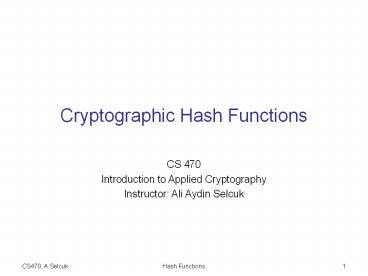Cryptographic Hash Functions PowerPoint PPT Presentation
Title: Cryptographic Hash Functions
1
Cryptographic Hash Functions
- CS 470
- Introduction to Applied Cryptography
- Instructor Ali Aydin Selcuk
2
Cryptographic Hash Functions
- Maps an arbitrary length input to a fixed-size
output. - Was originally proposed to generate input to
digital signatures. - Desirable features
- one-way (preimage and second preimage resistant)
- pseudorandom
- collision resistant
3
Collision Resistance
- But why collision resistance? (i.e., not just
one-wayness?) - A chosen p.t. attack Trudy is Alices
secretary.Generates two opposite messages, each
with vN (e.g., 232 for N 264) different ways of
putting it. - Repudiation Alice generates two different
messages and signs one of them. Later, she denies
her signature and claims she in fact signed the
other one. - Birthday Problem (paradox) When vN or more are
chosen randomly from a domain of N, there is a
significant chance of collision. - Hence, output size 128 bits is desirable.
4
Birthday Paradox
- E.g. N 106
5
Internals of a Hash Function
- Merkle-Damgard construction
- A fixed-size compression function.
- Each iteration mixes an input block with the
prev. output.
6
Merkle-Damgard Construction
- Input is broken into equal-sized blocks and fed
into the compression function. - Length padding 1000 (length of message).
(Why?) - Finalization Optional
- Provable security If f is collusion resistant,
the hash function is collusion resistant.
7
Hash Fnc. from a Block Cipher
- Compression fnc. from block cipher (Rabin)
- Split the message into key blocks. (why not pt.?)
- Encrypt a constant (e.g. 0) with this seq. of
keys. - Ciphertext is the hash output.
8
Hash Fnc. from a Block Cipher (cont.)
- Davies-Meyer Construction
- Hi Hi-1 ? Emi(Hi-1)
- Compression function is provably secure
(collision resistant) if E is a secure block
cipher.
9
MD5
64 rounds of
- Rivest, 1991
- Based on Davies-Meyer const.
- Very popular until recently.
- 2004 First collision attacks
- 2008 Practical collision attack SSL cert. with
same MD5 hash. - 2010 Forged Microsoft MD5 certificates used in
Flame malware - Preimage resistance Mostly ok.
10
Flames MS Windows MD5 Attack
- Chosen-prefix coll. attack Meaningful initial
blocks, followed by random blocks to obtain
collision.
11
SHA-1
80 rounds of
- Designed by NSA based on Rivests MD4 MD5
designs - SHA 1993 SHA-1 1995
- 160-bit output size
- 2005 Some flaws discovered.
- SHA-2 256- and 512-bit extension secure
- SHA-3 By public competition
12
SHA-3
- Public competition by NIST, similar to AES
- NISTs request for proposals (2007)
- 51 submissions (2008)
- 14 semi-finalists (2009)
- 5 finalists (2010)
- Winner Keccak (2012)
- Designed by Bertoni, Daemen, Peeters, Van Assche.
- Based on sponge construction, a completely
different structure.
13
Speed Comparisons
Algorithm Speed (MiByte/s.)
AES-128 / CTR 198
MD5 335
SHA-1 192
SHA-256 139
SHA-3 SHA-256
Crypto 5.6 benchmarks, 2.2 GHz AMD Opteron 8354
- NIST expects SHA-2 to be used for the foreseeable
future. - SHA-3 A companion algorithm with a different
structure and properties.
14
Things to Do with a Hash Function
- Hash long messages for signing
- Authentication protocols
- Stream ciphers
- Block ciphers
- MACs
- . . .
15
Authentication Protocol
- Challenge-response authentication instead of a
password protocol - Hash is used instead of block cipher encryption
EK(ra), EK(rb), decryption.
Alice
Bob
hello, ra
H(K ra), rb
H(K rb)
16
Stream Cipher
- CFB Oi H(K Ci-1) Ci Pi ? Oi Pi Ci ?
Oi - OFB Oi H(K Oi-1) Ci Pi ? Oi Pi Ci ?
Oi - CTR Ci Pi ? H(K IV i) Pi Ci ? H(K
IV i)
17
Block Cipher
- Use the hash function as the f in a Feistel
structure. - Luby Rackoff (1988) Three rounds are needed
for security.
18
MACs from Hash Functions
- A natural relative but how to do it best?
- prefix MACK(x) H(K x)
- not secure extension attack.
- suffix MACK(x) H(x K)
- mostly ok problematic if H is not collision
resistant. - envelope MACK(x) H(K1 x K2)
- HMAC MACK(x) H(K2 H(K1 x))
- provably secure popular in Internet standards.
19
VMAC
- Proposed by Ted Krovetz in 2006.
- Based on a universal hash rather than collision
resistant hash. (which is fine for MAC) - Extremely fast (3 GB/sec) adjustable
security-speed tradeoff. - VMAC-64 is about 10x faster than HMAC-MD5 has a
security proof that Pr(forgery) lt 2-60. - Very suitable for infrastructure (routers) or
low-end (RFID, WSN) authentication.

